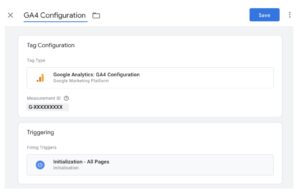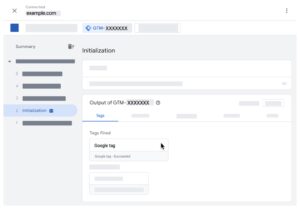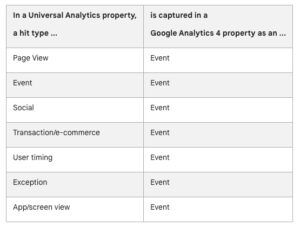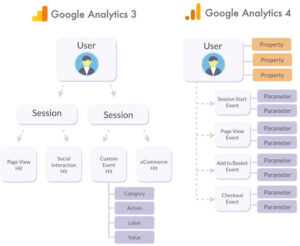Part 4 of many about GA4 and what is coming after UA
We will pick up this installment of the Analytics after UA here at the end of the last article GA4 Configuration by digging into segments and audiences.
With its robust audience builder and advanced generation tools, GA4 stands head and shoulders above Universal Analytics (UA). However, GA4 uses a unique approach to track screen views, unlike UA. Instead of treating mobile and web views separately, it combines data from both channels into one property. As a result, GA4 gives you a complete picture of a user’s journey across different devices, allowing for more comprehensive user profiles.
Think of audiences as specific groups of users (‘user segments”) that you can use for analysis and advertising.
Groups are formed based on a range of criteria, such as dimensions, page visits, user attributes, and events (or their sequences) relevant to your company.
For instance, you could compare the behavior of US users against all users or users originating from your app against mobile users and desktop users.
It’s worth noting that audiences are re-evaluated as new user data is collected in GA4 automatically.
Segments and audiences may seem similar, but they have some key differences. Segments are data sections that meet particular requirements and can be analyzed independently.
For example, you can compare the purchase behavior of your local users to the conduct of all users or mobile users to desktop users to gain deeper insights.
Segments allow you to segregate certain groups of people and compare their behavior to the rest of the data rather than analyzing data from all visitors.
GA4 Segments and Audiences
You can opt to develop an audience based on a segment while creating a segment, but these two capabilities are distinct. Segments cannot be used in regular reports, although audiences may.
Exploration reports in GA4 include segments but do not incorporate audiences. However, despite being present in these reports, audiences, as opposed to segments, can be utilized for remarketing campaigns. Audiences are created based on segments and are shared across Google’s advertising products, which makes them suitable for targeted ad campaigns. Conversely, while they can be created and applied within the Explore section of GA4, segments are not used directly in Google’s advertising products like Google Ads.
Most significantly, segments are retroactive, whereas audiences are not because they begin gathering information only from the moment they are created.
How To Create Segments
In GA4, navigate to Explorations > Create a New Exploration.


There are three types of segments you can create:
-
-
- User segment: Includes all events associated with users who satisfy a specific set of criteria.
- Sessions segment: Includes all events associated with those sessions that match the set of criteria.
- Event segment: Includes only specific events that meet a set of criteria.
-
Let’s dive into how each segment type works with a simplified model.
Let’s say the user who visited the website performed the following actions during the first session:
-
-
- Page view.
- Submitted form.
- Made a purchase.
-
On the second session the next day, the same user performed these actions:
-
-
- App click through.
- Page view.
- Made a purchase.
- Made a purchase.
-
If we create a user segment with the condition that the user submitted a form, it will contain data from all sessions because we tell GA4 to include all data that belongs to that user.
If we build the sessions segment with the condition that the user submitted a form during the session, it will contain only data from the first session because we told GA4 to retain data only from sessions where one has submitted a form.
Building a session segment of when someone watched a video will have data from both sessions because the user made a purchase during both sessions.
And finally, if we create an event segment for times when the user clicks a link, it will contain only click event data from the second session.
Segment Builder UI In GA4


Here are some of the features to know about within segment builder:
-
-
- Sequence is available only in user segments and isn’t configured for session or event segments. You can use it to know how many users subscribe after visiting your home page.
- You can apply time constraints to your segments. An example use case would be to know how many users visit your subscribe page and sign up within five minutes or how many users visit your product page and add it to the cart within five minutes.
- Group level scoping: applies to all conditions within the group and is either across all sessions or within the same session within the same event. Please note that you can use specific sequence level scoping “across all sessions” and “within the same session.” Note that “across all sessions” scoping is available only in user segments.
- “Exclusion group” is a valuable tool that allows you to refine your segment or audience by excluding specific users. For instance, you can create an audience comprising individuals who clicked the ‘Add to cart’ button but exclude those who have already purchased. An exclusion group enables you to develop a targeted audience for your remarketing campaign in Google Ads, specifically catering to those who expressed interest in your product but still need to complete the purchase.
- OR/AND conditional logic operators can apply multiple criteria simultaneously in the groups.
- By checking the “Build Audience” checkbox, you can also create an audience from that segment.
-
Example Of An Event Segment
Event segments are subsets of events triggered on your website or app.
Why would you need event segments if you already have users and session segments? Event segments, on the other hand, enable a more targeted and specific analysis than session-based or user-based segments.
They enable you to investigate people’s actions on your website and optimize the user experience.
As an example, let’s make a scroll-depth event segment. You may identify interesting sites by analyzing users that achieve specific scroll depth criteria, optimize content layout, and enhance overall user engagement.

In our case, we want to view data from people who went 50% of the way down the page and noted that only “within the same event” remained.
Granular scroll depth monitoring necessitates a specialized configuration, which we will discuss in the following steps. If you don’t have it configured, you may use the “scroll” event without the special parameter “percent_scrolled.”
Here are some examples of when you might want to use event segments instead of users or session segments.
-
-
- Clicks Events: Make a segment from click events like “Add to Cart” or “Submit Form.” A click event enables you to analyze sessions or users who actively engage with your call-to-action buttons and quantify the effectiveness of individual call-to-action buttons.
- Show Page Engagement:
- Interaction with Dynamic Content. Analyze interactions with dynamically loaded or personalized content pieces, such as image carousels, actor bios, or press releases.
- Video Engagement: A segment can be created depending on events such as “video_start,” “video_progress,” or “video_complete.” This segment lets you examine sessions or users interacting with video content on your website or app.
- Buy Tickets: Set up custom event monitoring to generate segments based on unique interactions important to your business, such as buy ticket button clicks (to your event ticketing site), to assist you in identifying and analyzing problematic sessions or individuals.
- Error Tracking: Form validation errors, broken links, and server-side problems can all be used to create a segment. The benefit: error-focused event segments allow you to discover and analyze sessions or users that faced issues, enabling you to improve error handling, fix broken elements, and improve the overall website or app operation.
-
Example Of A User Segment
At DWG, we have sign-ups, and we are interested in how long it takes a user to sign up for our newsletter after landing on our article pages.
For that, we should build a segment of users who visited the homepage for our shows, followed by a “buy_tickets” event within 5 minutes.
For that, we choose “first_visit” as an event.



If you want to apply a time constraint to a specific step, you can utilize the time constraint option within the sequence. However, in our case, we have chosen a sequence global time constraint, which applies to all steps within the sequence.
We’ve found from this segment that 7.5K out of 12K subscribers (50%) subscribe within 5 minutes when they visit the homepage.
If you run a shop, you can create a segment of customers who buy within a day of browsing a product page.
There are unlimited ways to use this, and I’d like to emphasize that GA4’s new segment or audience builder is far more flexible and powerful than Universal Analytics.
Here are a few ideas of segments you may need to use for a users segment:
-
-
- User Acquisition: Understand user behavior from different acquisition channels (organic search, paid ads, social media, email marketing, DSP). Tracking the user across to the event ticketing site across sessions with event tracking across all sessions. Get a full ROI of all your marketing efforts, based on revenue, order value, and purchase frequency.
- Demographic Analysis: Segment users by age, gender, location, or interests to personalize marketing strategies.
- Churn Analysis: Identify and re-engage users who have churned via remarketing campaigns.
- Cohort Analysis: Compare new and returning users’ engagement, retention, and conversion rates.
- Customer Lifetime Value (CLTV): Identify high-value users based on revenue, order value, and purchase frequency.
-
Example Of A Session Segment
While user segments help analyze long-term behavior and user attributes, session segments help analyze user interactions within a single session.
For content engagement analysis reports, session segments are the best option. For example, you can use session segments to analyze how visitors interact with various types of content on your website or to study user behavior based on referral sources.

In the sessions segment, everything is the same, but it no longer has the following:
-
-
- “Across all sessions” scope.
- Sequences.
- Time constraints.
-
Let’s build a segment of users who arrived at our website from social.

.*(?:facebook\.com|instagram\.com|twitter\.com|linkedin\.com|pinterest\.com|youtube\.com|t\.co|lnkd\.in).*
Here are a few ideas for how you can use session segments vs. users:
-
-
- Content Engagement: Analyze sessions where users interacted with specific content types.
- Campaign Performance: Evaluate sessions originating from specific marketing campaigns or channels to understand your marketing efforts’ effectiveness.
- Conversion Funnels: Analyze sessions that progress through crucial steps of your conversion funnel, from initial engagement to goal completion, helping you optimize the user journey.
-
As we learned how to use segment builder in UI, we can create an audience quickly. In the next part we will focus on the Audiences and get to the bottom of how to create audiences and multiple examples.
Dream Warrior Group, a Los Angeles Based web design and digital marketing Company, providing solutions for your online marketing needs. Our expertise includes Search Engine Optimization (SEO), Social Media Posts & Marketing & Google PPC campaigns. Call us now at 818.610.3316 or click here.








